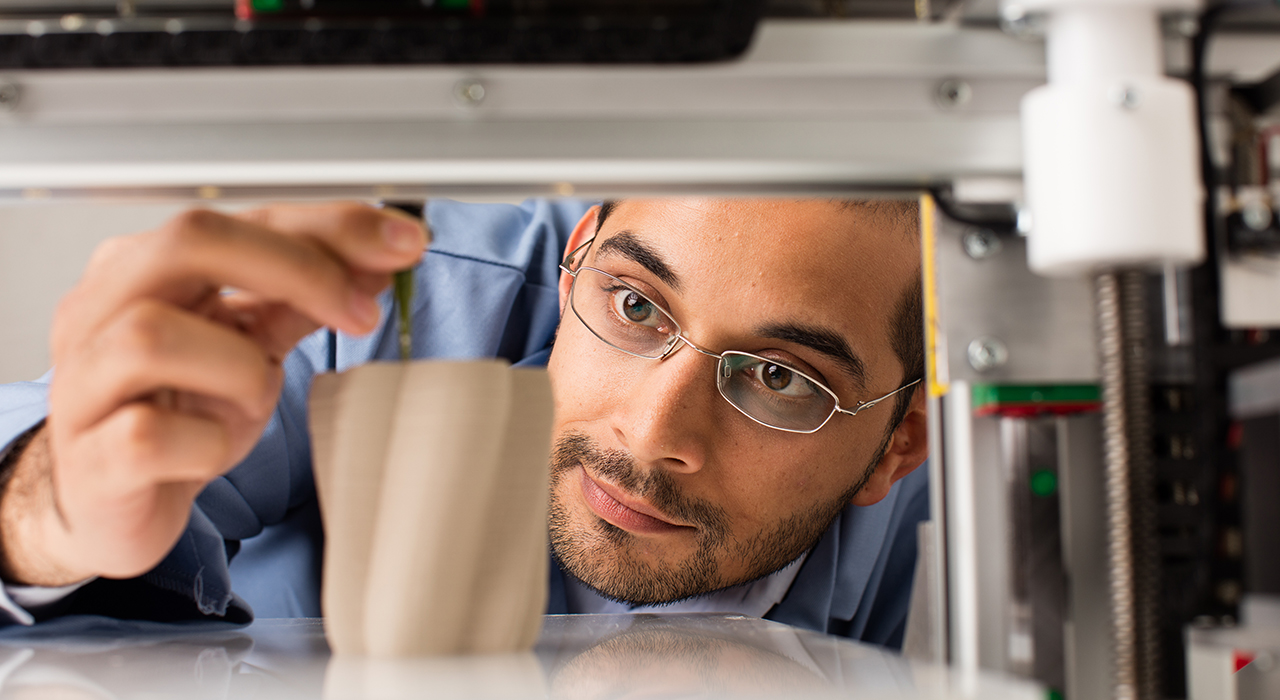
The worried parents had visited specialist after baffled specialist, unable to explain why their young son was missing developmental milestones like rolling over and crawling. At UCLA, the child became the first patient to undergo a new genetic analysis called exome sequencing. His test revealed a rare genetic condition known as Pitt-Hopkins syndrome. “The diagnosis gave us a point to move forward from, rather than just existing in that scary no-man’s land where we knew nothing,” his mother says. Since that first test in 2012, more than 4,000 patients have undergone exome testing at UCLA. More than 30 percent of difficult cases have been solved.
Breakthroughs like exome sequencing answer vital questions ― and raise new ones. That’s why innovation at UCLA extends far beyond a moment of discovery. Innovation here is an intentional process, piecing together patterns of evidence, exploring and testing new ideas, refining and building on each breakthrough. From the first medical devices used for stroke treatment to the first viable desalination filter, from breakthroughs in film preservation to insights in clinical psychology, UCLA has a long tradition of innovation. And that tradition powers a vision of the future that knows no limits.
Precision Health
No innovation looms larger than precision health, with its deceptively simple mantra: Deliver the right treatment, every time, to the right person. But to make precision health more than a promise, the power of big data and genomics must be leveraged. The Institute for Precision Health at UCLA aims to do just that. With a renowned hospital and top-ranked departments of mathematics, computer science, human genetics and biological science, UCLA is positioned to be a world leader in this new approach to medicine. A well- established culture of collaboration across disciplines provides a strong foundation.
Dr. Daniel Geschwind, physician and neuroscientist, is the inaugural associate vice chancellor of precision medicine for UCLA. His specialty is autism, and he talks about the progress made since 2001, much of it based on a biobank of DNA samples from children with autism spectrum disorders.
“Since then, we and others have identified 200 bona fide autism risk genes, half of them strong candidates and the other half representing possibilities,” Geschwind said. “Ten years ago, we knew none of them.” Geschwind’s lab at UCLA has played a major role in these discoveries and has done important work to develop a new understanding of people with autism spectrum disorders.
UCLA has already enjoyed success as a pioneer in precision medicine treatments for cancer. In the 1980s, the work of Dr. Dennis Slamon led to the blockbuster breast cancer drug Herceptin. Dr. Owen Witte’s work on leukemia led to the development of Gleevec. And Dr. Antoni Ribas, recipient of a 2015 “Giants of Cancer Care” award, was the principal investigator on the melanoma treatment Keytruda. The common thread among the three cancer therapies is genetic targeting.
“Physicians used to make decisions based on five or six data points,” says Steven Dubinett, head of UCLA’s Clinical and Translational Science Institute. “Now our goal is to help them make them based on thousands. We have the infrastructure and workforce to do that.”
Concrete Solution
While precision health may be the most expansive initiative at UCLA, the same interdisciplinary approach can be seen in other efforts. Take Gaurav Sant’s CO2NCRETE. The name tells the story: this daring technology literally recycles industrial pollution, CO2, into a building material that can be used like cement. Sant, an associate professor of civil and environmental engineering, leads a Carbon Upcycling team that includes professors J.R. DeShazo, public policy; Laurent Pilon, mechanical and aerospace engineering; Richard Kaner, chemistry and biochemistry, materials science; and Mathieu Bauchy, civil engineering.
There’s a dual benefit to CO2NCRETE. By removing CO2 from power plant smokestacks, this technology reduces the largest single source of greenhouse gas emissions. By creating a CO2-neutral building material, it also displaces cement, which is one of the largest industrial sources of emissions. The potential win-win has already inspired the Anthony and Jeanne Pritzker Family Foundation to donate $1.5 million to support the research and the team’s competition for the NRG COSIA Carbon XPRIZE.
“The next step involves scaling up the reactors, processes and systems required to produce CO2NCRETE,” Sant said in May. “This will help us overcome the challenges of producing CO2NCRETE in industrial quantities while ensuring the rapid capture of carbon dioxide and its benefits.”
New Life for Old Languages
Not all the innovation at UCLA happens in labs. Both the history and linguistics faculty are using 21st century technology to bring new life to indigenous languages of the Americas. UCLA historian Kevin Terraciano has studied the Mexican languages Mixtec, Zapotec and Nahuatl. He is part of a team working with the Getty Research Institute to create an interactive digital version of the Florentine Codex, a lavishly illustrated book written in Nahuatl, the tongue of the Aztecs. The codex, extant in a single copy in Florence, tells the story of the Spanish conquest of Mexico from an indigenous point of view. Terraciano is also the instructor of record for UCLA courses in Nahuatl. Via teleconferencing, students on campus converse with instructors from Veracruz, where modern Nahuatl is still spoken.
Linguistics professor Pamela Munro works on grammar and dictionaries for American Indian languages, including the Tongva language that was once spoken all over the Los Angeles Basin. Like Terraciano, she uses modern technology as well as the traditional tools of linguists. Her Tongva language Facebook page features a digital recording of the Tongva “word of the day.” The last native speakers of Tongva died in the middle of the 20th century. But the Tongva are reclaiming their linguistic heritage, and Munro is a valued mentor.
Both Terraciano and Munro mine the past in service to the future ― a future that will be richer because indigenous languages and cultures remain vital.
Reimagining Urban Life
Another kind of lab altogether is UCLA’s cityLAB, a think tank reimagining the architecture of the city. A vision for Westwood Village pictures intersections below ground and pedestrian-friendly outdoor “living rooms.” Downtown, cityLAB ponders turning a network of alleys and surface parking into a new type of public park. A prototype backyard home is sustainable as well as easy to build and customize, inexpensively adding space for an elderly parent or returning college student. In the “future of work,” faculty-led teams explore alternatives to the current trend for “creative space,” which prioritizes collaboration. Their work focuses on spots for “deep think” as well, allowing individuals and small teams places dedicated to concentrated thought.
While cityLAB’s principals are architects, they partner with researchers, faculty and students from all over campus. The backyard home, for instance, involved teams from environmental humanities as well as environmental science. cityLAB’s visionary drawings and prototypes provoke public conversation on the future of the city by making topics and proposals visible and tangible.
Sharing Innovation Through Startups and Licensing
With all the ideas and innovations bubbling up all over campus, it’s no wonder UCLA was recently recognized as the national leader in startups based on campus research. “Sandboxes” and incubators encourage experimentation in technology and entrepreneurship. There are more than 1,000 active U.S. patents in UCLA’s portfolio, and 114 new inventions were licensed to companies in 2015‒16 alone. “The entrepreneurial culture at UCLA will continue to drive the local economy and benefit the public with cutting-edge products,” says Amir Naiberg, associate vice chancellor of the UCLA Technology Development Group.
Because working across academic disciplines to turn ideas into innovations is what this research university is all about.


